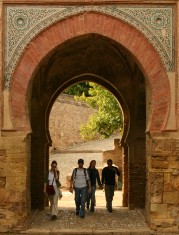





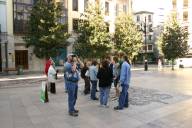
|
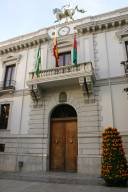
|
Our plan for this day was based on Mark’s having reserved tickets for a walking tour of the monuments of Granada, but not including the Alhambra. This meant getting up much earlier than the previous day, and getting breakfast as soon as the dining room opened, since our reservation was for 10:30.
We must have gotten to the town square in front of City Hall early, because there were relatively few people there for quite a while. You can see them in the first picture (small image, large); the second picture shows part of the façade of City Hall (small image; large). I don’t recall whether we ever heard the significance of the naked rider on the roof, holding a golden globe.
Before long a guide from the tour company came up, a very pleasant woman named Rosa whose English was much more than adequate. She made a head count of the people waiting there, and there were so many of us, with the great majority being English speakers — we were the only Americans there, I believe — that she called the tour company’s office to ask for another guide and an amplifying setup so that she could address the English speakers with the mike, and her colleague could take the smaller group of Spanish speakers off to the side. You see her at the left wearing her mike setup (small image; large).
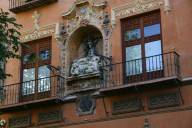
|
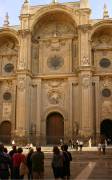
|
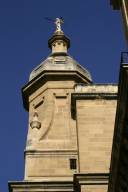
|
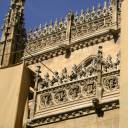
|
We started off from what I think of as Town Hall Square, but its real name is Plaza del Carmen. That’s not the woman’s name, nor a word for song, but a term referring to a certain kind of dwelling. Rosa led us around the city, pointing out various features of interest, and before long we were standing before the Cathedral. It’s not in a big open square like most of the French cathedrals you may know, but wedged tightly into a preexisting neighborhood in a relatively unesthetic manner. The Archbishop’s Palace is off to one side, and is an only somewhat interesting sample of Baroque architecture. Rosa pointed out (or was it another guide, later in our travels?) that with the Catholic Counter-Reformation in full swing, the religious emphasis in sculpture and art generally switched from the Crucifixion to the Virgin. And there she sits between the balconies (small image; large), somewhat stained by birds, I think. Some of us ducked into the Cathedral (small image, large), but not all: in fact Rosa somewhat discouraged the idea. It was Sunday, and our group was not small. As I recall, she asked us not to take pictures. To be honest, I don’t recall any details of the interior of the church, but you’ll see in later pages that the typical Spanish Baroque church interior is very lush, and eminently photographable.
In the photographs in the lower row, there are two architectural details from the cathedral. The left (small image; large) shows the cathedral’s weathervane, while the right shows an example of the frequent architectural use of the letters “F” and “Y”. These do not stand for what any speaker of English might think, but rather are the initials of the “Catholic Monarchs” Fernán and Yzabel, greatly revered in those days for their having united all the Spains into one. (Small image; large)
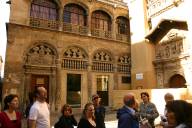
|
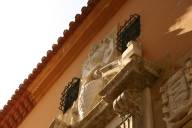
|
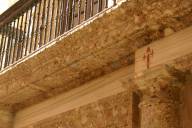
|
Here I might say a word about a justification that we heard more than once of that woman I’ve always thought of as one of the great villains of history. Rosa pointed out that by 1492, all the other countries of Europe had expelled the Jews from their borders, so what Isabella did in expelling the Jews from Spain was only an action in conformity with other nations’. The examples that are given of previously-acting countries are England and France, and neither of them was a center of Jewish culture the way that Spain had come to be, so the villainy involved in the English or French action was not nearly as great as Isabella’s.
The last three pictures are mostly of architectural interest. I don’t know what the building was in the background, but it shows nice renaissance detail (small image; large); some of our group are in the foreground, and you see Rosa in the extreme lower right corner. I liked the second picture in this group for the heraldic use of the helmet (small image; large) — and in the last one you can see the use of puddingstone for its decorative value (small image; large).
Go to the next day’s page; to the previous day’s page.
Return to the Spain index page; to my main page.